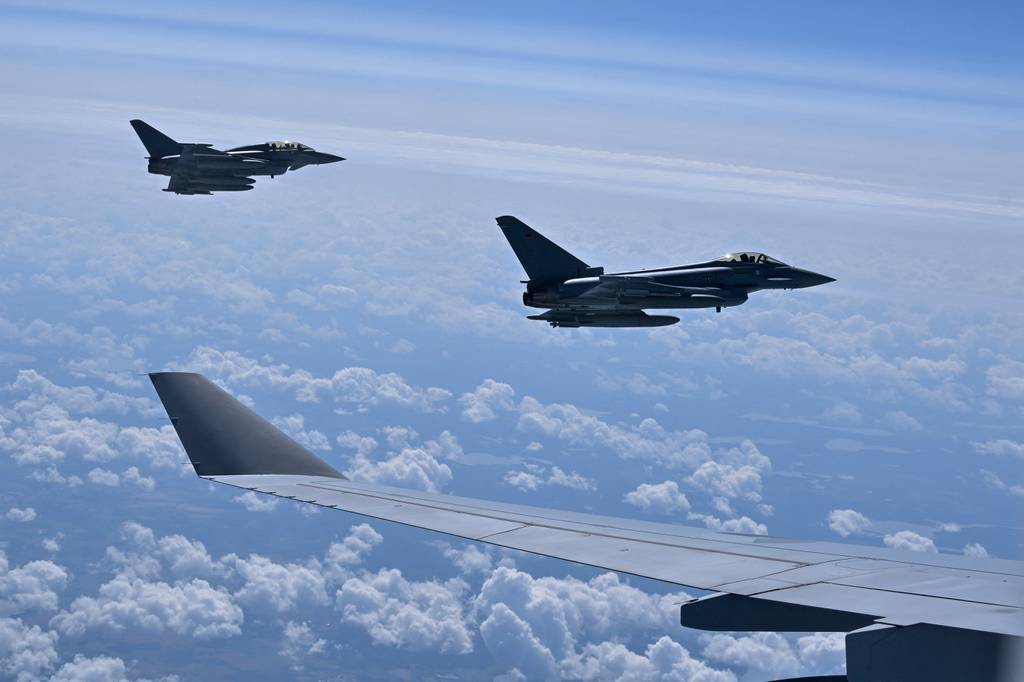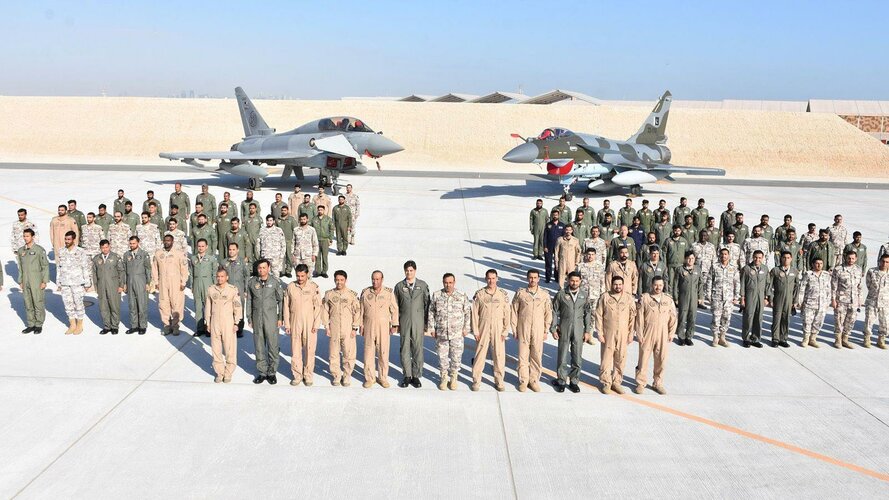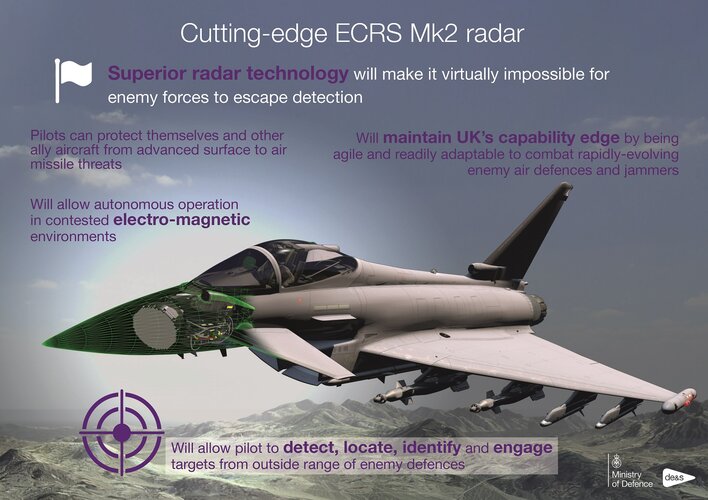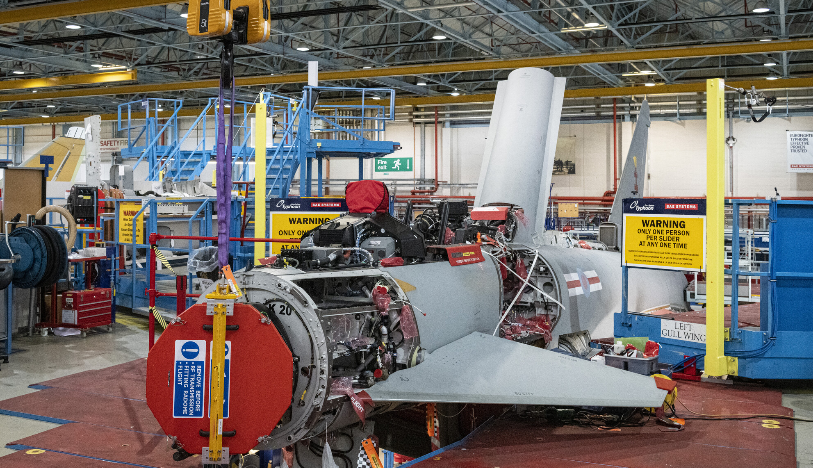You are using an out of date browser. It may not display this or other websites correctly.
You should upgrade or use an alternative browser.
You should upgrade or use an alternative browser.
Eurofighter Typhoon
- Thread starter Scorpion82
- Start date
A dark horse could be Mexico. The F-5Es are long overdue for replacement and a Tranche 1 can do the job just fine. The twin engines would be welcomed and Mexico has bought from Spain (and Europe) in the past.A Question...
The RAF is ''Reduce to Produce'ing' all of its Tranche 1 Typhoon. What happens to the Spanish and German Tranche 1's when replaced by Quadriga and Halcon? And the Austrian and Italian Tranche 1's when withdrawn? There could be c100 low mileage (less than half lifetime airframe hours) Typhoon Tranche 1 on the market over the next 6 years, all with some upgrade potential....I've advocated sending them to Ukraine for free, be interesting to see what the users do....will they scrap for parts like RAF? Or sell on? Or gift?
Realistically...
I think there will definitely be at least160c200 new build Typhoon (excluding the Kuwaiti and Qatari ones that are already being built and delivered). But it could reach240higher than that with a following wind. Any more than that would be a massive bonus....and a big surprise (it certainly won't hit 386 like Ordered and Potential Orders tally to above, but if it got to 240 that would be incredible).
red admiral
ACCESS: Top Secret
- Joined
- 16 September 2006
- Messages
- 1,468
- Reaction score
- 1,541
What's any difference between Tranche 3 and 4? Are there any hardware or software differences?
WatcherZero
ACCESS: Secret
- Joined
- 22 May 2023
- Messages
- 435
- Reaction score
- 750
Tranche 4/Quadriga has AESA radars and unspecified hardware and software modernisations of sub components, likely to address obsolesce. It was previously known as Tranche 3B.
red admiral
ACCESS: Top Secret
- Joined
- 16 September 2006
- Messages
- 1,468
- Reaction score
- 1,541
That's kind of my point. The Tranche 3 (some) and Tranche 2 (some) will also get AESA radars, of 3 quite different sorts. So that's not really a Tranche 4 thing.
I've yet to see any other changes specified.
I've yet to see any other changes specified.
WatcherZero
ACCESS: Secret
- Joined
- 22 May 2023
- Messages
- 435
- Reaction score
- 750
Yes but those are upgrades to tranche 2 and tranche 3 aircraft, they didnt come with the radar.
red admiral
ACCESS: Top Secret
- Joined
- 16 September 2006
- Messages
- 1,468
- Reaction score
- 1,541
Yes, but once upgraded is there any difference?
Scorpion82
ACCESS: Confidential
- Joined
- 20 May 2006
- Messages
- 104
- Reaction score
- 100
Ok I'll amend...
You did say that 160 was never going to happen though....
I have no crystal ball, but I'm not too optimistic for various reasons. Is there the potential? Theoretically yes, does it mean it'll happen? No, it might, but the track record of Eurofighter export sales isn't particularily convincing and unless the Eurofighter consortium can deliver on the paper promises it makes and not just a decade or more later, and that also requires the buy in from the nations itself and the will to make decisions on time and approve the budgets required to make it happen, I'm not holding my breath and manage expectations accordingly. You know, in 1998/1999 there were big plans to sell around 400 A/C by 2020. We are in 2024 and the competion isn't sleeping, threats are evolving and the window of opportunity becomes smaller and smaller...
Scorpion82
ACCESS: Confidential
- Joined
- 20 May 2006
- Messages
- 104
- Reaction score
- 100
What's any difference between Tranche 3 and 4? Are there any hardware or software differences?
Typhoon evolves continuously, a Tranche is just a contract, bit aircraft are build in Block standards which describe the physical configuration. The actual capabilities are most precisely described by the PSCs, for those who know what a PSC is and what it entails. The Block 60 standard, as T4 baseline standard expands on the Block 40K standard, which specific hardware provisions for future growth, obsolescence cures including comprehensive equipment upgrades/replacements as it happened in T3A. T4 aircraft will evolve in line with the overall planned evolution and might, at the beginning even lag behind existing aircraft which might have (started) to be upgraded to newer capability standards by the time Block 60 A/C are cleared and delivered. It's always a question of what is written into the cobteacts, what is feasible in delivery timescales etc. Most T3A aircraft were delivered at P1Ea standard for example, even as P2E/P3E had been introduced... Just as an example.
WatcherZero
ACCESS: Secret
- Joined
- 22 May 2023
- Messages
- 435
- Reaction score
- 750
RTX (Raytheon) is appealing the Italian governments decision to use its golden share to veto the $1.8bn sale of the Italian based Collins Aerospace subsidiary Microtecnica, which makes aircraft actuators and employs 3,600 across UK, Italy, France and Asia with an expected turnover next year of $1.5bn, to the French company Safran believing it would give them the ability to sabotage Eurofighter component production in favour of the Rafale.

 www.defensenews.com
www.defensenews.com

RTX threatens legal action against Italy over Microtecnica sale
Microtecnica is an Italian company that makes components for the Eurofighter jet built by Italy, Germany, the U.K. and Spain.
WatcherZero
ACCESS: Secret
- Joined
- 22 May 2023
- Messages
- 435
- Reaction score
- 750
Yes the P1Eb FW standard giving them limited ground attack through the addition of the computer symbol generator, digital video and voice recorder, laser designator pod and maintenance data panel.
Spain is also considering upgrading Tranche 2, Tranche 3, Halcon 1 and Halcon 2 (tranche 4 and 4+ standard), a total of 96 aircraft and any Haldon 3 purchase to the Long Term Evolution or LTE standard. The 17 Tranche 1 in the P1Eb FW standard wouldnt be upgraded.
Germany is likewise planning to upgrade all Quadriga, its tranche 3 and part of its tranche 2 to LTE but none of its tranche 1.
Spain is also considering upgrading Tranche 2, Tranche 3, Halcon 1 and Halcon 2 (tranche 4 and 4+ standard), a total of 96 aircraft and any Haldon 3 purchase to the Long Term Evolution or LTE standard. The 17 Tranche 1 in the P1Eb FW standard wouldnt be upgraded.
Germany is likewise planning to upgrade all Quadriga, its tranche 3 and part of its tranche 2 to LTE but none of its tranche 1.
Surprised that the RAF are going to strip the early Tranche 1 Tyhoons for spare parts for the rest of the fleet instead of upgrading them to Tranche 3 Typhoons. GCAP/Tempest cannot come quick enough in this case.
Justin Bronk: There are a few elements underwriting the tranche 1 retirement, the first one being that, of the 53 tranche 1s out of the 160 Typhoon we bought, about 30 were twin-seaters and not combat capable.
Chair: So they were for training.
Justin Bronk: Yes, for type-conversion training and other bits and bobs. Generally speaking, the RAF is now putting new pilots in their first solo into a single-seat Typhoon, so it does not draw on the twin seats nearly as much for the original conversion work, because the simulators are now very good and also, having had a chance to try it myself, it is a remarkably easy aircraft to fly - really amazingly so.
It is worth noting that the RAF’s safety record for Typhoon is perfect - touch wood. Having flown it more than any of the other European partners, the RAF has so far demonstrated exceptional flight safety, despite not using the twin-seaters very much for type conversion.
When they were trying to quickly build up a pool of instructors and pilots at the beginning of the programme, they really flew the wings off the twin seats, so most of them are knackered. One of the stories around, for example, retiring the tranche 1s with a large amount of their hours remaining is that the tracking of airframe life in that instance is referring to nominal flight hours, whereas it is a better metric to track fatigue index. The original aircraft, to put it bluntly, had their wings flown off.
One of the reasons that Typhoon is a superlative within-visual-range dogfighting aircraft is that it will sit at 9G for as long as the pilot can take it, but, of course, that puts huge strain on the aircraft. Metal aircraft generally have a shorter nominal lifetime, but you can extend it by replacing parts in a relatively predictable way, because we have decades and decades of understanding exactly how metal fatigues, whereas composites are much stronger and lighter, but they fatigue in a fundamentally different way and it is much harder to refresh airframe fatigue life once you have used it up.
A lot of the 30 or so that have gone so far were not combat capable to begin with; they were really worn out and, for the remaining tranche 1s, the argument was always that it was uneconomical to keep them, based on the opportunity cost of that money going elsewhere - for example, into more F-35s or operating the ones that we have more - because tranche 1 Typhoons are so expensive to fly relative to 2s and 3s.
Dave Doogan: Why is that?
Justin Bronk: Just because they are older. They also have obsolescence issues, so a lot of the electronics and hardware in it cannot be upgraded, at least not without a complete overhaul, which would be extremely expensive. The Germans, for example, are replacing theirs with new builds. You cannot upgrade them to use a lot of the newer software, which means that you are running much older software on much older hardware and on much more tired aeroplanes that break a lot more, so it just costs a lot more to fly them.
The one major loss in terms of output will be the loss of the dedicated aggressor training capability. At the moment, we have a squadron of mostly tranche 1s doing QRA and red air simulation. It is the highest in red air that is around in Europe and one of the highest in NATO, because most red air providers fly things like Hawk or Albatros trainers, not a supersonic high-end combat aircraft, so there will be a loss of capacity there.
Dave Doogan: So there is no economic opportunity from the disposal of all 53 tranche 1s. They will go for scrap and are no use to anybody.
Justin Bronk: I am sure you could find uses for some of them; the question will be how many. For the RAF, the choice is reasonable in terms of the argument that the money you would spend keeping them going could be better used elsewhere. For other operators that are looking for a Typhoon-type capability, it might make more sense if they are not trading off on a bespoke TyTAN-type support arrangement against things like F-35.
Last edited:
Forest Green
ACCESS: Above Top Secret
- Joined
- 11 June 2019
- Messages
- 5,102
- Reaction score
- 6,697
Appears Germany has wised up.
View: https://twitter.com/defense_news/status/1746746541161796051?s=20

 www.defensenews.com
www.defensenews.com
View: https://twitter.com/defense_news/status/1746746541161796051?s=20

German leaders abandon blockade of Eurofighter sale to Saudi Arabia
Defense analysts welcome the about-face, even as backlash is still brewing in Berlin's governing coalition.
WatcherZero
ACCESS: Secret
- Joined
- 22 May 2023
- Messages
- 435
- Reaction score
- 750
Appears Germany has wised up.
Yeah we mentioned it just over a week ago, enemy of my enemy is my friend and all that.
siegecrossbow
I really should change my personal text
- Joined
- 12 March 2012
- Messages
- 379
- Reaction score
- 741
Qatari Eurofighters Flying Against Pakistani J-10s In Exercise | Aviation Week Network
Qatari Eurofighter Typhoons are operating with Pakistani Chengdu J-10Cs in the first military drills bringing the two canard fighter types together.

- Joined
- 29 November 2010
- Messages
- 1,703
- Reaction score
- 3,212
looking at the J-10 side by side with the Typhoon, it looks like the J-10C cockpit looks a bit cramp for the pilot
FighterJock
ACCESS: Top Secret
- Joined
- 29 October 2007
- Messages
- 4,222
- Reaction score
- 3,413
The J-10Cs cockpit certainly looks smaller than the Typhoons that is for sure helmutkohl, I wonder what the PAF pilots would think of the Typhoons cockpit had they the chance of looking at it.
siegecrossbow
I really should change my personal text
- Joined
- 12 March 2012
- Messages
- 379
- Reaction score
- 741
looking at the J-10 side by side with the Typhoon, it looks like the J-10C cockpit looks a bit cramp for the pilot
Typhoon is a two seater though. The canopy has to be a bit bigger so the copilot could have a better field of view.
Scott Kenny
ACCESS: Above Top Secret
- Joined
- 15 May 2023
- Messages
- 5,999
- Reaction score
- 4,855
Right, but it also looks like the pilot's seat is higher relative to the canopy rails. Sitting on the plane, not in it.Typhoon is a two seater though. The canopy has to be a bit bigger so the copilot could have a better field of view.
WatcherZero
ACCESS: Secret
- Joined
- 22 May 2023
- Messages
- 435
- Reaction score
- 750
aonestudio
I really should change my personal text
- Joined
- 11 March 2018
- Messages
- 2,546
- Reaction score
- 5,969

Cutting-edge Typhoon Radar embodied for first flight - Defence Equipment & Support
A Typhoon fighter jet has been fitted with one of the world’s most advanced radars ahead of initial flight trials.

timmymagic
Forever disappointed in MoD procurement...
- Joined
- 23 August 2011
- Messages
- 1,055
- Reaction score
- 2,801
View: https://twitter.com/JonA2i/status/1747566264669626476
Also speculation that the ECRS Mk.2 and Large Area Display is crucial to the Saudi order going through....
Also speculation that the ECRS Mk.2 and Large Area Display is crucial to the Saudi order going through....
View attachment 717513
Cutting-edge Typhoon Radar embodied for first flight - Defence Equipment & Support
A Typhoon fighter jet has been fitted with one of the world’s most advanced radars ahead of initial flight trials.des.mod.uk
Notice the small error on the picture illustrating the report (see also post #741) Caution panel states:
Remove before:
- RF transmission
- fitting radome
- before flight
Can you really fly without a radome? Or does ground crew have to open the radome before each flight?!
Scott Kenny
ACCESS: Above Top Secret
- Joined
- 15 May 2023
- Messages
- 5,999
- Reaction score
- 4,855
Safety placards are supposed to be all encompassing.Notice the small error on the picture illustrating the report (see also post #741) Caution panel states:
Remove before:
- RF transmission
- fitting radome
- before flight
Can you really fly without a radome? Or does ground crew have to open the radome before each flight?!

BlackBat242
OK, I changed my personal text ;)
- Joined
- 10 April 2013
- Messages
- 776
- Reaction score
- 1,905
That cover (and the yellow bar) seem too big to allow the radome to fit over them.Notice the small error on the picture illustrating the report (see also post #741) Caution panel states:
Remove before:
- RF transmission
- fitting radome
- before flight
Can you really fly without a radome? Or does ground crew have to open the radome before each flight?!

F.L.
ACCESS: Top Secret
Spain propose Eurofighter Tranche 2 to Colombia !

 www.key.aero
www.key.aero
Spain offers second-hand Eurofighters to Colombia
The Colombian Air Force received a new Eurofighter Typhoon proposal from the Spanish government in early December, with the proposed deal reportedly covering the supply of between 12-16 second-hand Tranche 2 Eurofighters from the Spanish Air and Space Force
BlackBat242
OK, I changed my personal text ;)
- Joined
- 10 April 2013
- Messages
- 776
- Reaction score
- 1,905
Well, Columbia's eastern neighbor does seem to be making nasty noises, so it actually makes sense for them to upgrade their forces.
aonestudio
I really should change my personal text
- Joined
- 11 March 2018
- Messages
- 2,546
- Reaction score
- 5,969
Well, Columbia's eastern neighbor does seem to be making nasty noises, so it actually makes sense for them to upgrade their forces.
The record is definitively mixed. Argentina is a textbook case, TBH UK avenged (and still avenge !) from the Falklands via Martin Baker ejector seats. This has sunk countless Argentina new fighter procurements, all by itself. Last victim: the Super Etendards. They will be no coming back.
Besides Argentina very specific case, other south american countries often have balked at new fighters costs - versus the lack of serious air threat in the Americas by an large (no Houthis with drones or missiles, no big threat like Russia or China - or one Pacific ocean away, which ain't nothing). Plus Uncle Sam Monroe doctrine, for good or worse - USAF and USN colossal capabilities.
Who is gonna seriously challenge Paraguay or Uruguay, from the air ?
timmymagic
Forever disappointed in MoD procurement...
- Joined
- 23 August 2011
- Messages
- 1,055
- Reaction score
- 2,801
And their Kfir are rapidly approaching end of life...Well, Columbia's eastern neighbor does seem to be making nasty noises, so it actually makes sense for them to upgrade their forces.
F.L.
ACCESS: Top Secret
Yes, this year.And their Kfir are rapidly approaching end of life...
snne
ACCESS: Top Secret
- Joined
- 3 July 2022
- Messages
- 576
- Reaction score
- 1,546
Aren't those based on Mirage Vs with old Israeli avionics and J79s? (Basically still a 3rd gen aircraft)And their Kfir are rapidly approaching end of life...
F.L.
ACCESS: Top Secret
No, the Kfir is already a Mirage 5++.Aren't those based on Mirage Vs with old Israeli avionics and J79s? (Basically still a 3rd gen aircraft)
And the Colombian Kfir has been modernised with 4gen avionics.
BlackBat242
OK, I changed my personal text ;)
- Joined
- 10 April 2013
- Messages
- 776
- Reaction score
- 1,905
I was referring to Venezuela's recent declaration that they own about half of Guyana.The record is definitively mixed. Argentina is a textbook case, TBH UK avenged (and still avenge !) from the Falklands via Martin Baker ejector seats. This has sunk countless Argentina new fighter procurements, all by itself. Last victim: the Super Etendards. They will be no coming back.
Besides Argentina very specific case, other south american countries often have balked at new fighters costs - versus the lack of serious air threat in the Americas by an large (no Houthis with drones or missiles, no big threat like Russia or China - or one Pacific ocean away, which ain't nothing). Plus Uncle Sam Monroe doctrine, for good or worse - USAF and USN colossal capabilities.
Who is gonna seriously challenge Paraguay or Uruguay, from the air ?
Those three nations are at the opposite end of South America from Argentina, Paraguay, and Uruguay.
F.L.
ACCESS: Top Secret
In any case, interceptors are still necessary in the fight against drug trafficking by air.
Last edited:
In any case, interceptors are still necessary in the fight against drug trafficking.
Tucanos and M-346 can do that job no ? or A/T-50 ?
F.L.
ACCESS: Top Secret
Today, the situation in South America is fairly calm. But should things heat up, the threat posed by the Venezuelan Su-30 or Chilean F-16 requires a modern fighter.Tucanos and M-346 can do that job no ? or A/T-50 ?
Last edited:
WatcherZero
ACCESS: Secret
- Joined
- 22 May 2023
- Messages
- 435
- Reaction score
- 750
BAE has confirmed its assisting the UK government formulate a response to a fresh Statement of Requirements issued by Saudi Arabia.
aonestudio
I really should change my personal text
- Joined
- 11 March 2018
- Messages
- 2,546
- Reaction score
- 5,969
Similar threads
-
-
-
Air to Ground Combat Tactics: Use of PGM on night and poor visibility
- Started by Pit
- Replies: 3
-
-
Questions about Typhoon CAPTOR radar
- Started by ROCAF2003
- Replies: 0

